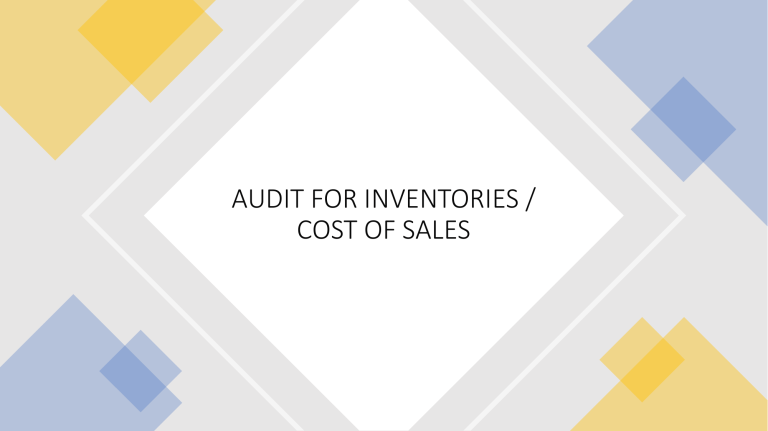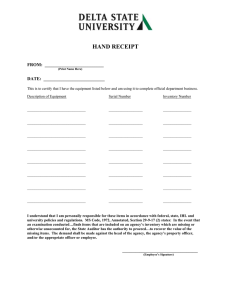
AUDIT FOR INVENTORIES / COST OF SALES Learning objective 1 • To identify the audit objectives for inventories, COS, and related accounts • Describe the primary substantive test audit procedure for inventories, COS, and related accounts • Identify assertions addressed by audit procedures for inventories, COS, and related accounts Introduction • Inventories are one of the significant portions of entities current assets especially for manufacturing, servicing, and trading industries. • What are the significant risks involved when auditing inventories? • What are the factors affecting the nature, timing, and extent of audit procedures for inventory? Audit objectives • What are the audit objectives in the audit of inventories? What assertions are accomplished thru these objectives? Name at least two Internal controls • What’s the importance of maintaining a perpetual inventory records instead of a periodic inventory system? • IF the entity is maintaining a perpetual inventory system where ending inventory is readily known/available, is physical count still necessary? WHY? • On the inventory count date, there should be a reconciliation of physical count, stock cards, and the general ledger account inventory. How is the reconciliation accomplished? How are the differences disposed of? Frauds on Inventory • Overstating issuances and understating receipts of goods to show small inventory quantities • Physical count of goods duplicated • Listing obsolete, slow-moving and shopworn goods as first class products. • Deceptive packing and mislabeling of products Audit Procedures • Verify Beginning inventories • Observing inventory counts and performing test counts • Confirming inventories held by others • Performing purchases and inventory cut-off • Checking appropriate valuation in accordance with accounting policies Audit Procedures • Performing lower of cost or NRV test • Determining whether any inventories have been pledged and reviewing purchase commitment, and • Performing test of details on COGS • Performing analytical procedures Verify beginning balances • General ledger are compared with inventory balances per audited FS of the preceding year in a repeat engagement • Review predecessor’s working paper when available • Vouching the disposition of the beginning inventory • Examination of purchase orders, receiving reports, and purchase invoices supporting the inventory Observation during inventory count and test controls • What assertion is accomplished thru observation? How is observation relevant as an audit procedure for inventory? • Compare the management’s Vs Auditor’s responsibility during inventory count Observation during inventory count and test controls • Observation may include ensuring the following • Client’s employees are complying with the written inventory count instruction • Items belonging to the audit client are accurately counted and recorded • Items to be excluded the inventory are either subject to satisfactory control and excluded from the counting process or are accurately counted and recorded, including a clear description of their non-inventory status. • Proper cut off has been established • Count tags, count sheets or stock cards are properly controlled. Observation during inventory count and test Counts • Test Count: • During observations, the auditor should make test counts of selected inventory items and trace it to the inventory count sheet. If there is a discrepancy between the number of items counted and the inventory count sheet, the auditor will normally perform a recount and any errors are resolved with the client. Observation during inventory count and test Counts Alternative procedures in lieu of observations • Examining internal control on inventories • Examining the availability of instructions and other records showing the client had carried out a well planned inventory count • Performing test counts on some items considered material and significant • Other procedures that the auditor thinks feasible and necessary. Confirmation of inventories held by others • When does an auditor perform confirmation for inventories held by third parties? • What are the requests or details found in the confirmation letter which will be sent to the custodian? • What happens if there are no replies received from the confirmation? What alternative procedures are done to confirm existence of such inventory? Confirmation of inventories held by others • Alternative procedures • Inspection of: • Shipping docs • Receipts from logistic companies • Reports of and payments for subsequent consignment sales; and • Correspondence with the third party. • Consideration of whether physical inspection of the inventory is required. Year-end inventory/Purchase cutoff • Primary objectives: Existence, Occurrence, Completeness • What are the common purchase cutoff concern? CUT OFF PROCEDURES: • Examining a sample of receiving reports for inventory receipts immediately before and after the inventory count to check whether its recorded in the correct accounting period; and • Examining a sample of shipping docs for shipments immediately prior to and subsequent to the count to check whether it is recorded in the correct accounting period. Reconciliation of Inventory Summary Sheet with General Ledger Review of reconciliation: • Footing the reconciliation • Reconciling the book and physical inventory figures to the compilation and uncorrected general ledger respectively • Investigating significant differences between book and physical inventories • Reviewing the nature of the reconciling items • Agreeing reconciling items to the supporting working papers, adjusting journal entries and the general ledger • Verifying that an accrual for inventory received prior to the count date, but not billed, was included in books. Valuation in accordance with Accounting Policies • What standard addresses the question – “What method of valuation does the client use?” Explain the prescribed valuation as recommended by the standard. • What standard addresses the question – Is the method of valuation the same as that used in prior years?” Explain how any changes of valuation is accounted for according to the standard. • To make sure that there is consistency of application of valuation method, auditor will test: • Raw Materials – verified with purchase invoice • WIP & FG – cost is traced to the accounting records. Lower of Cost or NRV • To verify NRV of inventories, the following should be observed • F/G = based on selling prices (evidences: subsequent sales, list price, contracts) less any estimated cost to dispose them • WIP = based on selling prices less any estimated cost to complete and dispose the item. • RM = based on replacement cost (by purchase or reproduction) less any estimated cost to complete and dispose the item. • *Note that raw materials are no longer subjected to lower of cost or NRV test IF the NRV of the resulting F/G exceeds its cost. • Write-down or reversal should be charged to expense (COGS) Determine whether any inventories have been pledged and review purchase commitment • How does an auditor confirm the existence of a pledged inventory to secure a bank loan? How are they presented to the FS? • What should an auditor do if there are purchase commitments by the client? Perform test of details on COGS • To perform the test, the auditor requests for the related COS info (subsidiary ledger of COS), and reconcile it with a corresponding accounting record depending on the understanding of the inventory transaction cycle of the audit client • Corresponding accounting record: • corresponding credit in inventory accounts for the audit period • Corresponding sale transaction • After reconciliation, the auditor divides the COS into two population: total debits and total credits. Perform test of details on COGS • To perform the test, the following audit procedures may be done: 1. The auditor makes audit selections on both populations 2. The auditor obtains audit evidences such as PO, invoices, shipping docs, proof of payments 3. Vouch the details on step 1 to evidences obtained on step 2 • Determine the appropriate general ledger account used by inspecting material description on the purchase order • Determine if the accurate amount was recorded (check invoice) • Determine if the recorded COS pertains to the entity (evaluate when the title of the goods were transferred) • Determine if the cost was valid by checking the proof of payment Analytical procedures 29 Questions • How would you proceed in the audit of products that are subject to rapid obsolescence? Examples are cellphones, digital cameras, computer programs, computer hardwares, etc

